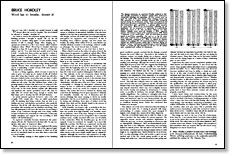
Synopsis: Wood is a complicated material, and there is a lot of essential information to become familiar with, so is truly a shame that the subject has been made even more confusing by erroneous ideas, such as wood being a living, breathing material. Because misconceptions are so rampant and can be so misleading, a review of some of the more common fallacies is worthwhile. R. Bruce Hoadley, celebrated wood technologist and the author of the classic Understanding Wood, tackles several big myths here.
“But I was told I shouldn’t use varnish because it really doesn’t allow the wood to breathe. The wood should be allowed to breathe, shouldn’t it?”
As I tried to answer the telephone inquiry about a routine finishing problem, I thought to myself, “Oh, oh, the old ‘wood has to breathe’ thing again.” It took another twenty minutes of talk to untangle things. After hanging up, I opened my notebook to a list I once started, called Common Confusion about Wood. “Wood has to breathe” had been logged in as Item 2B. It goes with 2A, “Wood is a living substance,” and 2C, “You must feed and nourish wood to keep it well.” I wonder how these notions get started, or where to begin separating fact from fiction, to clarify the confusion. Wood is such a complicated material, and there is so much vital information to become familiar with, it is truly a shame that the whole subject has been made even more confusing by such wrong ideas as wood somehow being a living, breathing material. Because these misconceptions are so rampant and can be so misleading, a review of some of the more common fallacies will be worthwhile.
A tree is a living organism, which of course it must be in order to grow. It is made up of a myriad of cells, all of which were alive when they formed, some of which are still alive, but most of which (in the wood of the tree) are dead. A cell is considered alive if it contains living protoplasm and a nucleus within the cell cavity. The thin cambium layer, which is the growing interface between bark and wood, is composed of living cells. Cambium cells can divide to produce new bark and wood cells. As the newly divided cambial cells differentiate and transform into various specialized wood cells, they remain alive for several days—long enough to assume their final shape and to develop the full cell-wall thickness.
In newly matured sapwood, however, only a few cells (roughly 10%) remain alive. They are called parenchyma cells. By retaining their living contents, they are able to assimilate and store carbohydrates and perform other metabolic functions. But all the cells other than parenchyma lose their protoplasts after maturing and are therefore non-living. They may still participate in the tree’s life functions by providing a means of sap conduction through their now empty cavities (vessels in hardwoods or tracheids in softwoods), or they may simply strengthen and support the tree according to their relative cell-wall thicknesses.
From Fine Woodworking #14
For the full article, download the PDF below:
Fine Woodworking Recommended Products

Ridgid R4331 Planer

AnchorSeal Log and Lumber End-Grain Sealer

DeWalt 735X Planer




















Log in or create an account to post a comment.
Sign up Log in